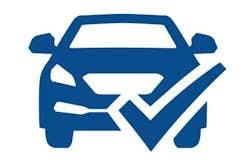Hyundai Launches Recognized Collision Repair Center Program
Hyundai Motor America launched its all-new Hyundai Recognized Collision Repair Center program in July. The program will recognize both independent and Hyundai dealership-owned collision repair centers based on having the required training, tools, equipment, and facilities needed to properly repair Hyundai vehicles after they have been involved in a collision.
Assured Performance Network will manage Hyundai ’s program enrollment, online support systems, proof of compliance documentation and marketing.
“We want our customers to know we have their well-being in mind after they have been in a collision,” said Frank Ferrara, executive vice president, customer satisfaction, Hyundai Motor America. “Hyundai owners benefit from this program through the assurance that centers will ensure the fit, finish, durability, safety and value of the vehicles being repaired. Having a network of recognized shops is critical to make sure our cars are repaired properly.”
Dorn’s Body & Paint in Mechanicsville, Va., is one of the first collision repair centers to join the Hyundai network. Owner Barry Dorn, a past chairman of the Society of Collision Repair Specialists, says the program is not only a significant step for Hyundai, but also a prime example of the recent shift in the automaker’s position in the collision repair process.
Why is Hyundai’s launch significant to the industry as a whole?
Through a national organization like SCRS, Assured Performance Network and others [the Automotive Service Association and the Alliance of Automotive Service Providers], collision repairers have firmly recognized the automakers as an entity that establishes the standard of repair for our industry. Through better partnerships between manufacturers like Hyundai who design and build these highly complex vehicles, and the sophisticated repairers who want to raise the bar through properly executed repairs, the consumer wins by having better confidence in their vehicles after a collision by knowing the repairs were performed properly.
—Barry Dorn, owner, Dorn’s Body & Paint
The Hyundai program puts it all in writing—what has to be done, what equipment is needed, what training is needed—for the shops to properly and correctly repair the vehicle.
The days of cold rolled steel are steadily going by the wayside. Repairs to ultra high strength steel, aluminum, and carbon fiber are daily occurrences in well-equipped collision facilities and structural riveting and bonding has become more commonplace. The days of assuming you know what to do to fix these vehicles without the proper equipment and training from the OEM is steadily going away, and many advancements require a cultural shift by repairers to embrace working with the OEM on defining the proper accepted repair approach.
The OEMs see the value of this business arrangement with those who are repairing their vehicles and that’s why they’re introducing these programs. They clearly understand that consumers are being harmed by problematic repairs that aren’t made with the appropriate tools or methods as defined by the manufacturers. Improper repairs can be dangerous, not to mention harm the performance of the vehicle and its designed crash-management system.
Hyundai is requiring I-CAR Gold Class recognition, advanced equipment and thorough documentation to perform repairs safely. You look at the level of detail as to what they’re requiring, and they’re sending a very clear message that they only want their cars repaired at places that understand how they’re built and understand how to put them back to the way Hyundai designed them and built them to be repaired.
What advantage does recognition give to a shop?
Quite simply, the recognition from an automaker like Hyundai is one of the most influential signals to the customer that they are at a facility that wants to fix the vehicles the correct way. Everyone seems to have lost the understanding of who designed and built the car. The OEM’s are under increased pressure to increase fuel efficiency, and still deliver an excellent product that is sophisticated, sleek and equally thoughtful of the repair methodology. Delivering this has become more and more complicated.
Can all shops go down this path to recognition? Should they?
I don’t think it’s for every shop, and I don’t think all shops will have to or be able to do it all. But for those committed to equipping and training and building a culture that follows the available procedures, there will always be a place for shops to be involved.
Something shops should consider is that it’s not one time and you’re done. It’s an ongoing investment in producing a product, a better service and a better understanding of this type of specialization.
It’s a complete culture change that all repairers that are involved need to embrace.
Do you see this leading to a higher level of specialization among shops?
I definitely feel the industry will become more specialized. I think it has to. Unless fuel requirements get lower and OEMs can go back to simple cold rolled steel and less restrictive platforms, I don’t see that changing going forward.
Information starts with everyone involved and the repairers and carriers need to understand that the way business has been done for many years must come to an end. It cannot continue down this path with all the new materials and requirements that are here now. Repairers have to understand their limitations. It cannot be the old standard of “we can fix anything.”
About the Author

Bryce Evans
Bryce Evans is the former vice president of content at 10 Missions Media, overseeing an award-winning team that produces FenderBender, Ratchet+Wrench and NOLN.
